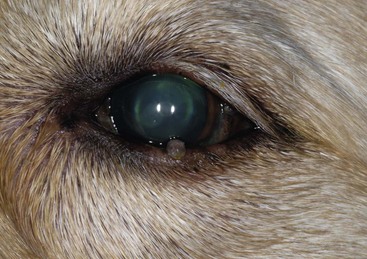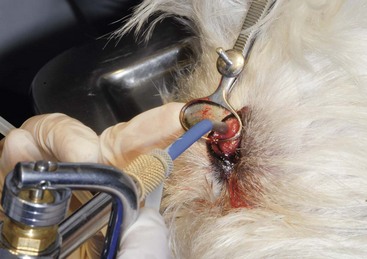Chapter 257 The most common canine eyelid neoplasms are meibomian gland adenoma and epithelioma (Figure 257-1) These tumors are benign but locally expansive, arising from the sebaceous glands and glandular epithelium, respectively. They typically occur in older dogs, have an irregularly textured to cobblestone surface, and can be seen protruding from the meibomian gland orifice as a pink, gray, or black mass at the eyelid margin. If the tumor remains within the meibomian gland it may cause obstruction of the gland orifice, resulting in accumulation of the glandular lipid secretions within the duct. When rupture of the gland ensues, marked granulomatous inflammation may develop in response to the release of inflammatory lipid products into the surrounding tissues. This secondary inflammation may give a small meibomian gland adenoma a falsely large appearance and can be quite uncomfortable for the patient. Meibomian gland adenomas and epitheliomas also can cause significant corneal irritation, and although these rarely are a direct cause of corneal ulceration, they may prevent epithelialization and delay corneal wound healing when an ulcer is present. Figure 257-1 Meibomian gland adenoma in the lower central and upper lateral eyelid of a mixed-breed dog. Surgical resection is the treatment of choice for most canine eyelid tumors. Surgical options include full-thickness eyelid resection, carbon dioxide laser ablation, and surgical debulking with cryoablation. When full-thickness eyelid resection is performed, it is imperative to achieve perfect reapposition of the eyelid margin to ensure normal eyelid function and long-term corneal health. Surgical debulking with cryoablation is an alternative to full-thickness eyelid resection that does not require general anesthesia in most patients. It can be performed under sedation (e.g., dexmedetomidine 375 to 500 µg/m2 IV and butorphanol 0.1 mg/kg IV) and local anesthesia (0.5 ml of lidocaine 2% infiltrated into the base of the neoplasm). After an open-closed chalazion clamp is placed over the eyelid and tumor, small scissors are used to excise all neoplastic tissue visibly extruding from the meibomian gland orifice. Gentle digital pressure may be applied to the palpebral conjunctiva to extrude any glandular contents. If the tumor can be visualized through the palpebral conjunctiva, a No. 15 Bard-Parker scalpel blade can be used to sharply excise the overlying conjunctiva to the level of the tumor, which allows débridement with a 3- or 4-mm curette or sharp excision using Stevens tenotomy scissors. It is important not to incise the eyelid margin using this debulking approach and to ensure that any incisions extend only through the palpebral conjunctiva. After the majority of the tumor material has been removed, cryoablation can be performed using liquid nitrogen in a dispensing canister with a flat probe attached (Figure 257-2). The size of the ice ball generated provides an estimate of the depth of cryopenetration. Use of two complete freeze-thaw cycles is recommended. The size of the tip selected for the cryoablation unit should approximate the size of the base of the tumor. Postoperatively, patients should be treated for 5 to 7 days with a broad-spectrum ophthalmic antibiotic ointment. Swelling and epidermal depigmentation occur commonly at the site of cryoablation, but repigmentation may be expected within weeks to months. In rare cases depigmentation remains at the eyelid margin, which may be a concern in patients for which cosmesis is important. Figure 257-2 Intraoperative photograph demonstrating the use of an open-closed chalazion clamp to isolate a meibomian gland adenoma of the upper eyelid. A cryoprobe has been applied directly to the palpebral conjunctiva overlying the base of the tumor.
Canine Ocular Neoplasia
Primary Ocular Neoplasia
Adnexa and Conjunctiva


![]()
Stay updated, free articles. Join our Telegram channel

Full access? Get Clinical Tree


Canine Ocular Neoplasia
Only gold members can continue reading. Log In or Register to continue
